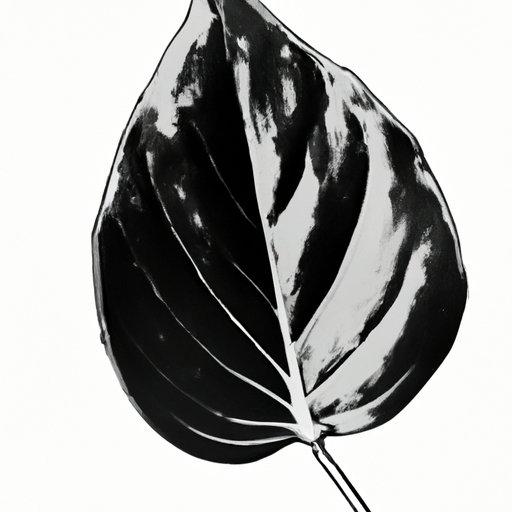
Introduction
Are you interested in drawing leaves but not sure where to begin? Whether you’re a seasoned artist or a beginner, drawing leaves can be a fun and rewarding experience. This comprehensive guide will help you master the techniques needed to draw realistic and beautiful looking leaves. From basic shapes to adding texture and color, we will walk you through the steps to become an expert leaf artist.
Start with the Basics: A Step-by-Step Guide to Drawing Simple Leaf Shapes
When drafting a leaf, it is important to start with the basic shape. Leaves come in all shapes and sizes, and while there are endless variations, most leaves can be categorized into a few basic shapes. The most common leaf shapes include circular, oval, heart, spade, and lanceolate.
Begin drawing a circular leaf by sketching out a rough circle. Then, add a small tail at the bottom of the circle to create the stem. An oval leaf is similar to a circular leaf, but elongated. A heart-shaped leaf is formed like the traditional heart shape, with a pointy tip and a curved base. A spade-shaped leaf looks like an upside-down heart, with a pointed tip and a flared base. Finally, a lanceolate leaf is long and narrow, resembling a sword.
When drawing any type of leaf, it is essential to keep the proportions accurate. Pay close attention to the size of the stem and the shape of the leaf. A common mistake beginners make is drawing the stem too thick or the leaf too small.
Experiment with Different Textures: Tips for Adding Depth and Detail to Your Leaves
Texture is crucial when it comes to creating realistic-looking leaves. Leaves have unique veins, bumps, and patterns that differentiate them from one another. There are various techniques that artists can use to incorporate different textures into their drawings, including cross-hatching and stippling.
Cross-hatching is a shading technique that involves drawing multiple lines at different angles to create depth. Begin by drawing thin parallel lines across the surface of the leaf. Then, draw another layer of lines diagonally across the first set of lines. The result is a diamond-like texture that can add depth and shadow to your drawing.
Stippling is a technique where small dots are used to create shading. Start by drawing small dots close together to construct a dense pattern. Combine different sizes of dots to enhance the depth of your leaf. The main advantage of stippling is that it provides a unique texture to your leaf drawings, which you cannot get from other drawing techniques.
Use Real-life References: How to Observe and Sketch a Variety of Different Leaf Types
Observation is a crucial element when it comes to drawing realistic-looking leaves. Studying real-life references, whether it be a tree nearby or a plant in your garden, is the best way to learn and improve your drawing skills. Observe the shape of the leaf, its color, texture, and any unique features, and try to capture these characteristics in your drawing.
Different types of leaves require different techniques when drafting. Broad leaves like those of a maple tree have a unique width and tend to have more detail than needle leaves like those of a pine tree, which are long and thin. Paying close attention to these details will set your leaves apart from your peers.
Mix Things Up with Color: Techniques for Shading and Color Blending to Create Realistic-Looking Leaves
Color is a vital component of drawings, including leaves. Simple shading techniques can quickly add dimension and detail to your illustrations. When it comes to shading, the application of different tones and shades of color is crucial to creating realistic-looking leaves.
Layering colors is an excellent technique to create depth in your drawing. Adding a darker shade of green to the edges of a leaf, followed by a lighter shade in the middle, can create a 3D effect. Alternatively, you can mix your colors to generate different shades or use a blending brush to mix colors on your drawing paper.
Branch Out with Creativity: How to Incorporate Leaves into More Complex and Imaginative Illustrations
Leaves can add variety to your artwork, and with a bit of creativity and imagination, they can find a place in virtually any artistic creation. For example, you can create a story by drawing a forest with different animals hiding behind the leaves. Leaves can also be used to form patterns or create shapes; they can act as filler or the main subject of the drawing.
When putting together a composition that includes leaves, it is important to consider balance and proportion. Leaves should flow seamlessly with other elements in the image and create harmony.
Capture the Beauty of the Changing Seasons: Drawing Leaves in Autumnal Shades to Create a Seasonal Masterpiece
Leaves change their colors as the seasons change, with autumn leaves being the most beautiful. To capture the essence of autumn, use a combination of yellows, oranges, and reds to create the unique colors of fall. Shading your leaves using these colors can create a vivid, breathtakingly beautiful scene.
Take It Further with Mixed Media: Ideas for Incorporating Leaves into Other Art Forms, Like Collages or Mixed Media Pieces
Incorporating leaves into other art forms is a great way to enhance your creative output. You can use different painting techniques to give depth and dimension to your leaves. Alternatively, you can use collage to add leaves to other materials, like photos or wood. Mixing leaves with other art forms often leads to fascinating results.
Conclusion
Drawing leaves requires a deep level of observation and attention to detail. However, by following the tips mentioned in this article, you should be able to create beautiful leaf drawings with ease. Remember to start with the basics, incorporate different textures and shading techniques, and take inspiration from the beauty of nature. With time and practice, your leaf drawing skills will eventually improve, allowing you to create fantastic works of art.




